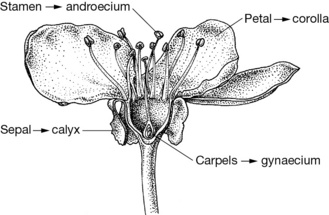Chapter 3 General principles of botany
morphology and systematics
 ‘Pick-a-cheese’ may be a widely distributed garden plant and weed known also as ‘common mallow’ which has the botanical name of Malva sylvestris or it may be some other botanical species known under the same common name.
‘Pick-a-cheese’ may be a widely distributed garden plant and weed known also as ‘common mallow’ which has the botanical name of Malva sylvestris or it may be some other botanical species known under the same common name.
 Upon your request the patient brings you a branch of the plant and with the help of the scientific (botanical) literature you make a positive identification of this plant as Malva sylvestris. The identification is based on the features of the plant (leaves, fruit, flowers) that you are able to observe.
Upon your request the patient brings you a branch of the plant and with the help of the scientific (botanical) literature you make a positive identification of this plant as Malva sylvestris. The identification is based on the features of the plant (leaves, fruit, flowers) that you are able to observe.
 In checking the active constituents (especially polysaccharides) you come to the conclusion that the plant is unlikely to contribute to the symptoms as they were reported by the patient. The plant is widely used as a local food item (also, for example, in Mediterranean France) and as a household remedy. Toxic natural products seem to be absent. Therefore, the search for a cause of the hypokalaemia continues…
In checking the active constituents (especially polysaccharides) you come to the conclusion that the plant is unlikely to contribute to the symptoms as they were reported by the patient. The plant is widely used as a local food item (also, for example, in Mediterranean France) and as a household remedy. Toxic natural products seem to be absent. Therefore, the search for a cause of the hypokalaemia continues…
[For further information on Norfolk country remedies readers are referred to Hatfield G 1994 Country remedies. The Boydell Press, Woodbridge.]
Plants and drugs
In the context of pharmacy a botanical drug is a product that is either:
• derived from a plant and transformed into a drug by drying certain plant parts, or sometimes the whole plant, or
• obtained from a plant, but no longer retains the structure of the plant or its organs and contains a complex mixture of biogenic compounds (e.g. fatty and essential oils, gums, resins, balms).
The large majority of botanical drugs in current use are derived from leaves or aerial parts.
Taxonomy
Example of Botanical Classification
The opium poppy, Papaver somniferum L.
Binomial: this is the genus and species names, plus the authority. Thus, in this example, Papaver somniferum is the binomial (the basic unit of taxonomy and systematics). It is followed by a short acronym (in this case ‘L.’), which indicates the botanist who provided the first scientific description of the species and who assigned the botanical name [in this example, ‘L.’ stands for Carl von Linnaeus (or Linné), a Swedish botanist (1707–1778) who developed the binomial nomenclature].*
Species: somniferum, here meaning ‘sleep-producing’.
Genus: Papaver (a group of species, in this case poppies, which are closely related).
Family: Papaveraceae (a group of genera sharing certain traits, named after one of the genera).
Subphylum: Magnoliphytina (seed-bearing plants with covered seeds).
Division (= Phylum): Spermatophyta (seed-bearing plants).
Kingdom: Plantae (the plants), one of three kingdoms, the others being the animals and fungi.
* In some cases, there is first a name in parentheses, followed by a second name not in parentheses. For example, in the case of the common aloe, Aloe vera (L.) Burm. f., the name in parentheses indicates the author (Linnaeus) who first described the species but assigned it to a different genus. The second name in this case, Burm. f., stands for the 18th century botanist Nicolaas Laurens Burman; f. stands for filius (son), since he is the son of another well-known botanist who provided numerous first descriptions of botanical species.
Morphology and anatomy of higher plants (spermatophyta)
Flower
The flower (Fig. 3.1) is the essential reproductive organ of a plant. It is frequently very showy in order to attract pollinators, but in other instances the flowers are minute and difficult to distinguish from the neighbouring organs or from other flowers.
Stay updated, free articles. Join our Telegram channel

Full access? Get Clinical Tree



